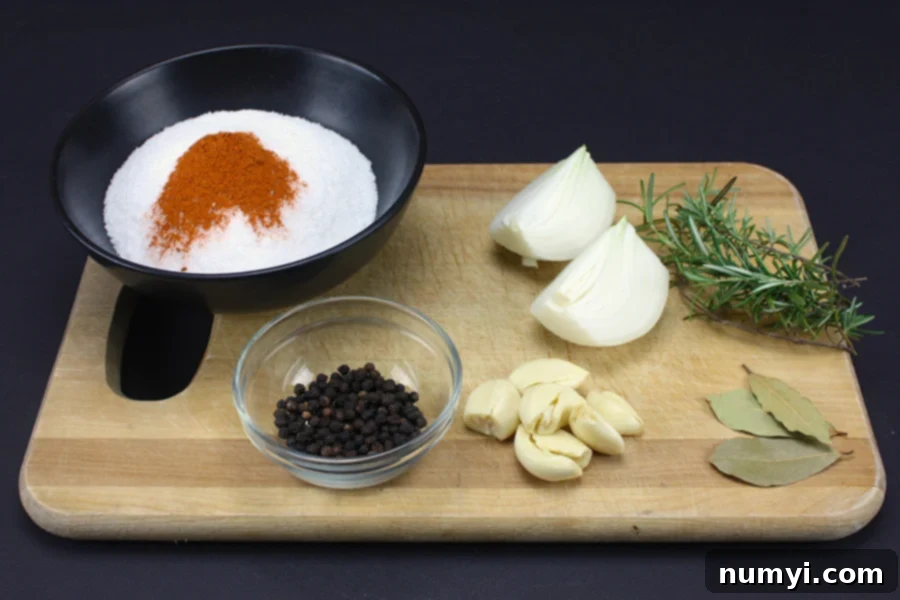Master the Art of Juicy Pork: The Ultimate Simple Pork Shoulder Brine Recipe
Achieving consistently succulent and flavorful pork can sometimes feel like a culinary challenge. Often, pork can turn out dry and less tender than desired. This is where the magic of brining comes in. This brine recipe, designed specifically for a pork shoulder (also known as a pork butt), is a game-changer, guaranteeing a wonderfully moist and tender result every single time. While perfect for large cuts like pork shoulder, its fundamental principles and the simple aromatic flavors make it incredibly versatile for almost any cut of meat you want to infuse with extra juiciness and taste. The true power behind this simple preparation lies primarily in the salt, but the accompanying aromatics elevate the experience, transforming your pork from good to unforgettable.
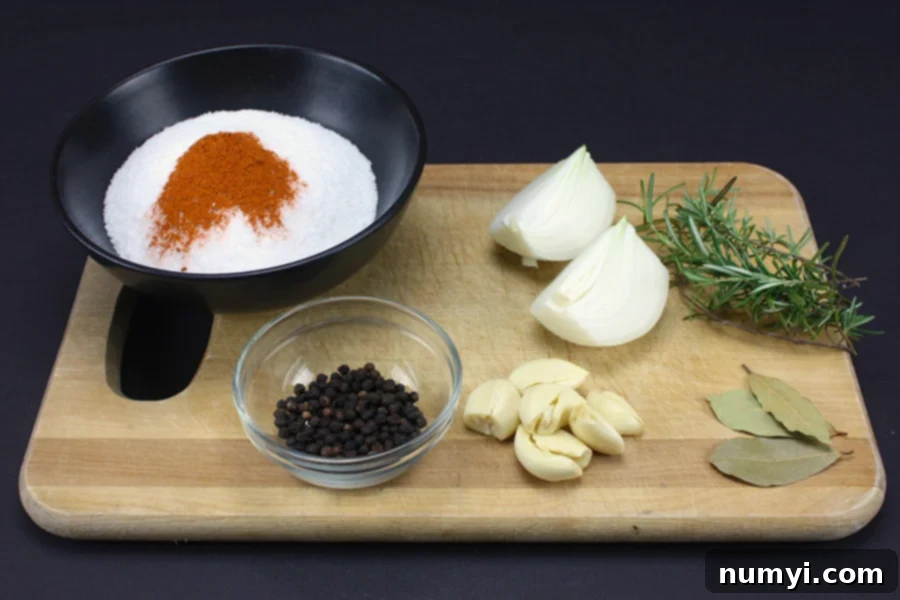
Why Brining Your Pork Shoulder is a Game-Changer
Brining is a classic culinary technique that guarantees a truly superior eating experience, especially with cuts like pork shoulder. The fundamental reason this recipe works so well is that it makes whatever you’re cooking come out all the juicier and more flavorful.
While we won’t delve into the ultra-technical aspects of osmosis and salt ions, the core principle is simple and incredibly effective: brining prevents dehydration while cooking, which means a much moister, more tender, and flavorful piece of meat. When meat is submerged in a saltwater solution (brine), the salt denatures the muscle proteins, causing them to unravel. This process allows the meat to absorb additional moisture and salt from the brine. During cooking, this extra retained moisture acts as an internal safeguard, minimizing the loss of natural juices and keeping your pork from drying out, even during long cooking processes like smoking or roasting. The result is pork that is not only succulent but also evenly seasoned from the inside out.
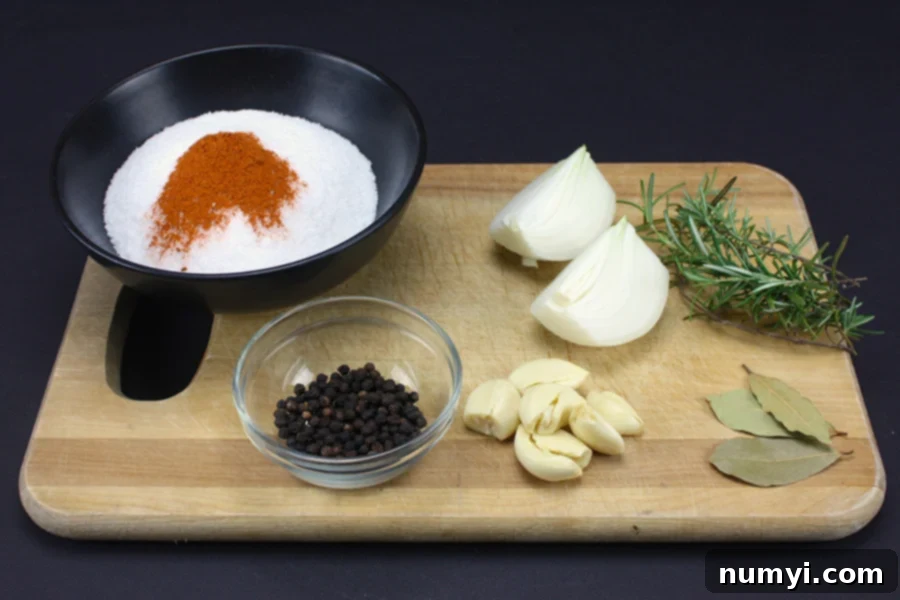
A basic brine is a simple mixture of salt, sugar, and various aromatics. For this particular pork shoulder brine, we utilize a combination of rosemary, onion, bay leaf, peppercorns, paprika, cayenne, and garlic. These ingredients provide a balanced and deeply savory base that complements pork beautifully, but the beauty of brining lies in its adaptability. You have the freedom to add whatever flavor profile you like, making it a truly customizable experience to match your culinary vision.
Beyond simply adding moisture, brining contributes to a more tender texture. The salt helps to break down some of the tougher muscle fibers, ensuring that even a hearty cut like pork shoulder becomes wonderfully yielding. This pre-seasoning also means that your meat will have a depth of flavor that goes far beyond surface-level rubs, resulting in a more consistently delicious dish.
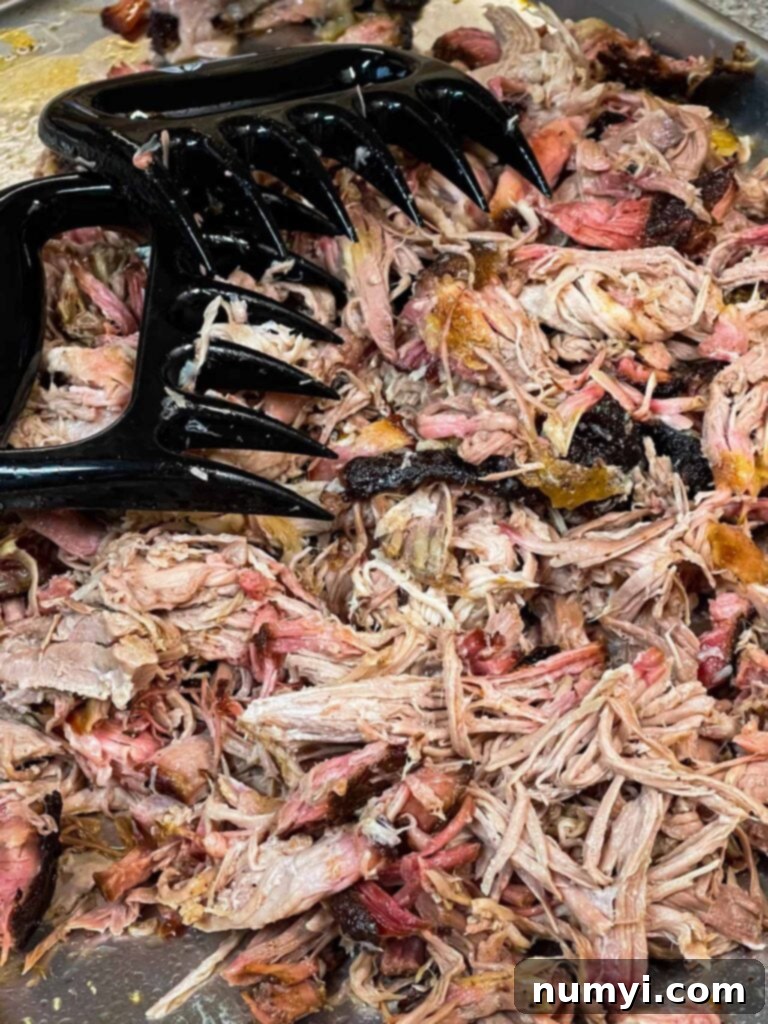
Crafting Your Perfect Brine: Essential Ingredients and Customizations
The foundation of any great brine is surprisingly simple, yet the impact on your final dish is profound. Our basic recipe includes a carefully chosen blend of ingredients that enhance the pork’s natural flavors and ensure maximum juiciness.
The Power of Salt and Sugar
The primary ingredient in any effective brine is, undoubtedly, salt. For this recipe, we specify kosher salt, and for good reason. Kosher salt has larger crystals than standard table salt, which makes it easier to measure accurately and dissolve evenly without compacting too much. It also lacks the iodine found in many table salts, which can sometimes impart an undesirable metallic taste to the meat. The salt is the true driving force behind the brining process, facilitating moisture retention and deep seasoning.
Sugar, while sometimes overlooked, plays an important supporting role. It helps to balance the saltiness, preventing the meat from becoming *too* savory. More importantly, sugar contributes to better caramelization and browning on the exterior of the pork during cooking, creating that irresistible crust or bark, especially crucial for smoked or roasted pork. You can use granulated white sugar or brown sugar for a slightly deeper, molasses-like flavor.
Aromatic Foundation: Our Simple Blend
Our recommended aromatics for this pork shoulder brine are designed to provide a rich, savory, and slightly peppery flavor profile that complements pork exceptionally well:
- Rosemary Sprigs: Fresh rosemary adds a wonderful piney, woodsy aroma that pairs beautifully with pork and is a classic choice for roasted meats.
- Onion (Half): A simple half onion provides a foundational savory sweetness that deepens the overall flavor of the brine and, consequently, the pork.
- Bay Leaves: These contribute a subtle, herbaceous, and slightly floral note that adds complexity without overpowering.
- Peppercorns (Whole): Black peppercorns infuse a gentle, earthy heat and classic peppery flavor throughout the meat.
- Garlic (Cracked Cloves): Cracked garlic releases its pungent, aromatic oils into the brine, imparting a robust and irreplaceable savory backbone.
- Paprika: Sweet paprika adds a mild, earthy sweetness and a beautiful reddish hue, which can enhance the visual appeal of your pork.
- Cayenne Pepper: A touch of cayenne provides just a hint of warmth and subtle spice, elevating the flavor profile without making the brine overtly hot.
While this blend is highly recommended for its classic appeal, remember that the world of flavor is your oyster! You can add whatever flavor profile you like, experimenting with different herbs, spices, and even liquids to tailor the brine to your specific dish or personal preference.
Step-by-Step: How to Prepare and Use Your Pork Shoulder Brine
Preparing this simple pork shoulder brine is straightforward and doesn’t require any special equipment or complicated steps. Let’s walk through the process to ensure your pork turns out perfectly juicy every time.
1. Dispelling the Hot Water Myth
Some brine recipes might instruct you to use hot water to dissolve the salt and sugar. This is not necessary at all for a basic brine. While hot water can speed up dissolution, it means you can’t add your meat to the brine until it completely cools down, which adds unnecessary time to the process. You can use room-temperature or even cold water; the salt and sugar will dissolve just fine with a little stirring. Prioritizing cold water ensures food safety and prevents any risk of partially cooking the meat or raising its temperature before brining.
2. Mixing the Brine Foundation
In a large bowl, stockpot, or a food-grade bucket, combine 10 cups of water with the kosher salt and sugar. Stir vigorously for several minutes until both the salt and sugar are completely dissolved. It’s crucial that there are no undissolved crystals remaining, as this ensures an even brining effect and prevents overly salty spots on your meat.
3. Assembling Your Brining Vessel
Once your salt and sugar are fully dissolved, gather your chosen receptacle for the pork. For ease and efficiency, we highly recommend using a large, heavy-duty brining bag or a large, durable zip-top bag. This method allows you to remove excess air, keeping the meat fully submerged in the brine without having to use weights. Alternatively, a large non-reactive pot or container with a lid will work, but you may need to place a plate or other clean weight on top of the pork to ensure it stays fully immersed.
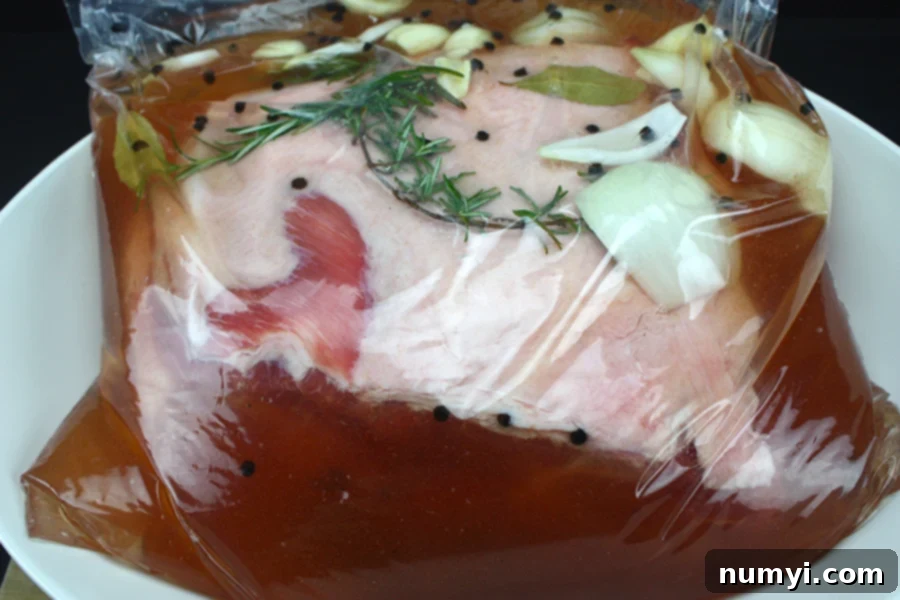
4. Combining Ingredients and Brining
Place your pork shoulder into the chosen brining vessel. Add all the remaining ingredients—rosemary sprigs, peppercorns, bay leaves, half an onion, cracked garlic, paprika, and cayenne—to the brine. Pour the liquid brine over the pork, making sure the entire piece of meat is covered. If using a plastic bag, carefully squeeze out as much air as possible before sealing tightly. If using a container, ensure it has a tight-fitting lid.
For absolute food safety, immediately place the covered pork and brine into the refrigerator. If you’re using a plastic bag, it’s a good idea to place it inside a roasting pan or a larger bowl. This acts as a safety measure, catching any potential leaks and preventing brine from contaminating other items in your fridge.
5. Brining Duration
For an 8-pound pork shoulder, we recommend brining for approximately 18 hours. Brining overnight (around 12-16 hours) is also perfectly acceptable and will yield excellent results. The brining time is largely dependent on the size and thickness of your meat. Smaller cuts of meat, such as pork chops or tenderloins, will require significantly less time, typically between 4 to 8 hours. It is generally not recommended to go over 24 hours with this brine, especially for standard cuts, as this might result in an overly salty experience for some palates.
6. Post-Brine Preparation
Once the brining time is complete, carefully remove the pork shoulder from the brine. Discard the used brine and any solids. There is no need to rinse the meat under water; simply pat it thoroughly dry with paper towels. Patting dry is a critical step because a dry surface promotes better browning and the formation of a delicious, crispy bark during the cooking process. Rinsing can wash away some of the surface flavor and prevent that desired crust.
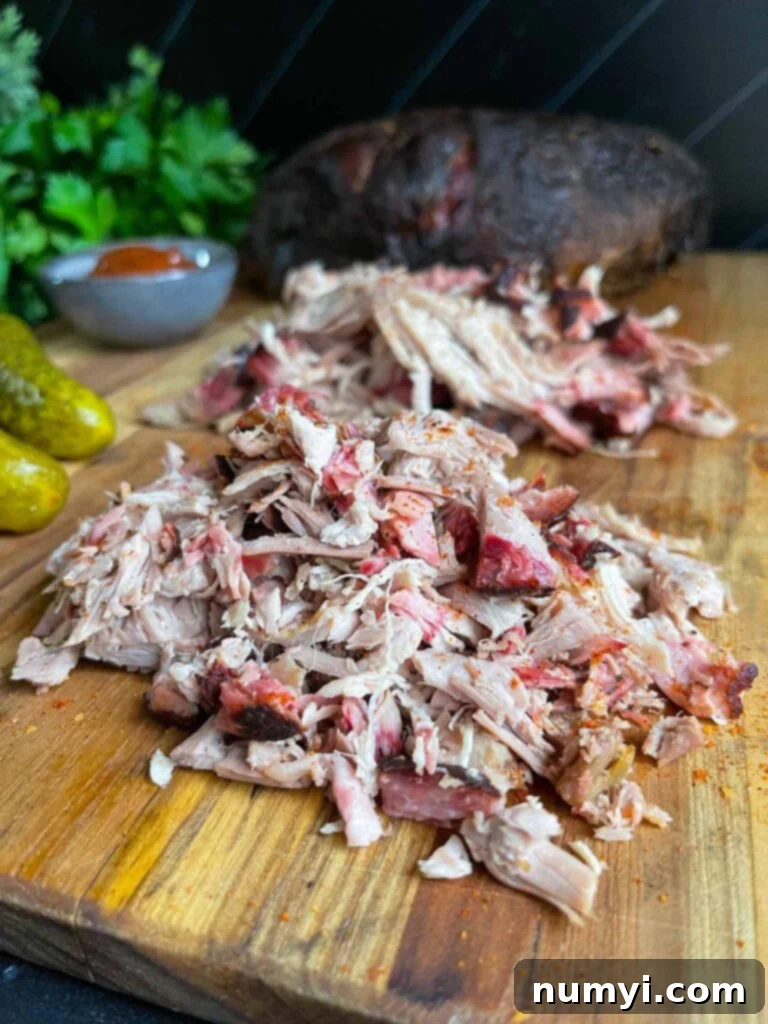
Once your pork is properly brined and patted dry, it’s ready for its next culinary adventure! Whether you’re planning to roast, grill, or smoke it, the brine has already set the stage for a phenomenally juicy and flavorful meal. For us, the next step often involves applying a very tasty rub and preparing a fabulous smoked pork butt, creating pulled pork that’s tender enough to melt in your mouth.
Elevate Your Dish: Creative Brine Variations
While the simple brine recipe outlined above is incredibly effective and delicious, one of the most exciting aspects of brining is the endless potential for customization. The main ingredient of every brine is, of course, salt—it’s the powerhouse responsible for moisturizing and binding with the protein to prevent water release during cooking. However, the other components of the brine are entirely up to your imagination, allowing you to infuse your pork with virtually any flavor profile you desire.
Here are some creative variations to inspire your next culinary masterpiece:
- Mediterranean Elegance with Herbes de Provence: Using Herbes de Provence (also known as Provençal herbs) adds a complex, aromatic spice blend regionally accurate to southeastern France. This delightful mix, typically including savory, marjoram, rosemary, thyme, and oregano, often with lavender, goes perfectly with pork, infusing it with a fragrant, earthy, and slightly floral essence.
- Bold Flavors with Creole Seasoning: For a vibrant and zesty kick, consider incorporating Creole seasoning. This robust blend is often built around the “trinity” of onion, celery, and bell pepper, along with garlic, paprika, cayenne, and other spices. It makes everything pop, and the tastebuds come alive with its spicy, savory, and aromatic notes, perfect for a lively barbecue or stew.
- Sweet and Spicy Heat: Other fun spice blends work exceptionally well with this brine. Things like Honey Habanero, a citrus mojo spice blend (featuring orange, lime, and garlic), or any kind of sweet heat rub would all work wonderfully, adding layers of sweet, tangy, and fiery flavors that penetrate deep into the meat.
- Asian-Inspired Brine: For an umami-rich and aromatic twist, incorporate soy sauce (reducing the amount of kosher salt slightly to account for the sodium in soy sauce), fresh ginger slices, star anise pods, a few drops of sesame oil, and a touch of five-spice powder. This creates a deeply savory and fragrant pork perfect for stir-fries or Asian-style pulled pork.
- Mexican Fiesta Brine: Infuse your pork with the vibrant flavors of Mexico. Add cumin, chili powder, dried oregano, orange zest, bay leaves, and a few whole dried chipotle peppers (for smoky heat). This brine will prepare your pork for fantastic carnitas, tacos, or enchiladas.
- Apple and Herb Brine: For a classic, comforting flavor, replace some of the water with apple cider. Add fresh sage, thyme sprigs, and a touch of maple syrup or brown sugar. This combination is especially delightful for roasted pork shoulder, providing a sweet and savory, autumnal profile.
- Garlic and Herb Garden Brine: Maximize herbaceous flavors by adding a generous amount of fresh parsley, sage, rosemary, and thyme, along with extra cracked garlic cloves. A splash of white wine or apple cider vinegar can also brighten the profile.
Don’t be afraid to experiment! Start with a foundational flavor, then add spices and herbs that you love. Just remember to taste your brine before adding the meat (ensure it’s not too salty or overwhelmingly flavored) and adjust quantities to suit your preference. The possibilities are truly endless, allowing you to tailor your pork to any cuisine or occasion.
Frequently Asked Brining Questions (FAQ)
The ideal brining time for pork depends heavily on the size and thickness of the cut. For large cuts like pork butts (shoulders), 12 to 24 hours is generally recommended, with 18 hours being a sweet spot for an 8-pound cut. Smaller cuts of pork, such as chops or tenderloins, require less time, typically ranging from 4 to 8 hours. It’s important not to exceed 24 hours for most cuts, as the meat can become excessively salty.
Brining transforms pork in two key ways: it dramatically increases moisture content and infuses flavor. The salt in the brine penetrates the meat, causing the muscle proteins to denature or unravel. This restructuring allows the meat to absorb and hold more liquid, preventing moisture loss during cooking and resulting in a much juicier, more tender final product. Additionally, the salt and other aromatics in the brine are absorbed into the meat, ensuring deep, even seasoning throughout, not just on the surface.
No, generally you should not rinse the meat after brining. Rinsing can wash away some of the surface flavor that contributes to a delicious crust or bark during cooking. Instead, simply remove the meat from the brine and pat it thoroughly dry with paper towels. The only exception is if there are large particles, such as whole peppercorns or herb sprigs, adhering to the meat that you wish to remove.
Yes, absolutely. Refrigeration is a critical food safety requirement while brining. The meat must be kept at a temperature below 40°F (4°C) throughout the entire brining process to prevent the growth of harmful bacteria. Always ensure your brining container is covered and placed in the coldest part of your refrigerator.
No, for food safety reasons, brine that has been in contact with raw meat should never be reused. It can harbor bacteria from the raw meat. Always discard used brine immediately after removing your pork.
Kosher salt is highly recommended for brining. Its larger crystal size makes it easier to measure accurately and dissolve, and it’s free of iodine, which can sometimes impart an off-flavor to the meat. Avoid iodized table salt, as its fine grain can lead to over-salting quickly, and the iodine can negatively impact flavor.
It is best to fully thaw pork before brining. Brining partially frozen meat can lead to uneven salt absorption, as the frozen sections won’t absorb the brine as effectively as the thawed parts, potentially resulting in an inconsistently seasoned and textured final product. Always thaw meat completely in the refrigerator before starting the brining process.
Other Delicious Recipes
Smoked Pork Shoulder (Pork Butt)
Pork Butt Burnt Ends Recipe
Double Bone-In Smoked Pork Chops
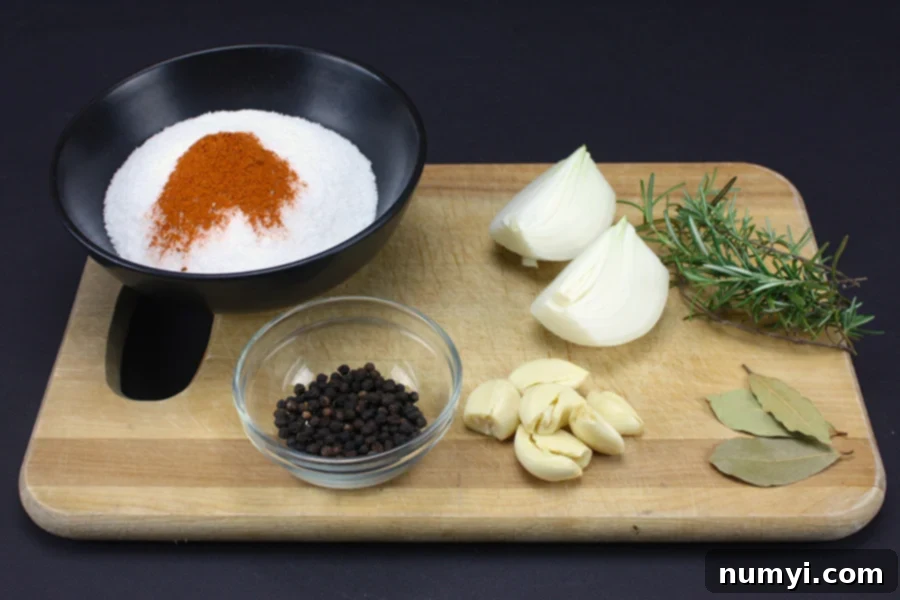
Simple Pork Shoulder Brine Recipe
Print
Pin
Rate
Ingredients
- 10 C Water
- 3/4 C Kosher Salt
- 1/2 C Sugar
- 4 Rosemary Sprigs
- 2 tbsp Peppercorns
- 2 Bay leafs
- 1/2 Onion
- 6 cloves Garlic, cracked
- 1 tbsp Paprika
- 1/4 tsp Cayenne
Instructions
-
In a large pot or bowl, dissolve the kosher salt and sugar completely in the water. Stir well to ensure no crystals remain.10 C Water, 3/4 C Kosher Salt, 1/2 C Sugar
-
Add the remaining aromatics and spices to the dissolved brine: rosemary sprigs, peppercorns, bay leaves, half an onion, cracked garlic, paprika, and cayenne. Stir to combine.4 Rosemary, 2 tbsp Peppercorns, 2 Bay leafs, 1/2 Onion, 6 cloves Garlic, cracked, 1 tbsp Paprika, 1/4 tsp Cayenne
-
Place the pork shoulder into a large, heavy-duty brining bag or a non-reactive container. Pour the brine over the meat, ensuring it is fully submerged.
-
Seal the bag (removing as much air as possible) or cover the container with a lid. Refrigerate for 12-18 hours. For an 8lb pork shoulder, 18 hours is ideal. Adjust brining time based on the size of the cut (smaller cuts require less time). Do not brine for more than 24 hours to avoid over-salting.
-
Once brining is complete, remove the pork from the brine and discard the liquid and solids. Pat the pork thoroughly dry with paper towels. Your pork is now ready for cooking!
Notes
Remember, salt is the crucial element for keeping the meat moist during cooking, especially for methods like smoking or roasting. Any other aromatics you add will enhance and customize the flavor. Feel free to mix it up with your favorite flavor profiles – from herbs de Provence to a spicy Creole blend!
